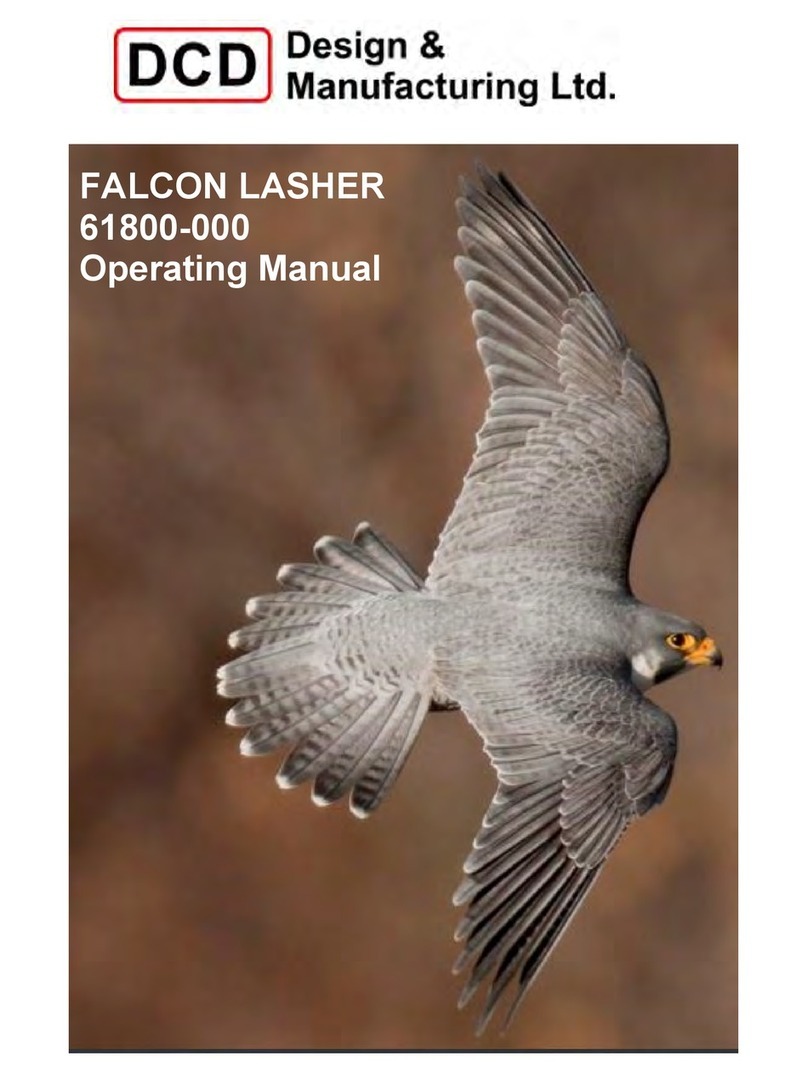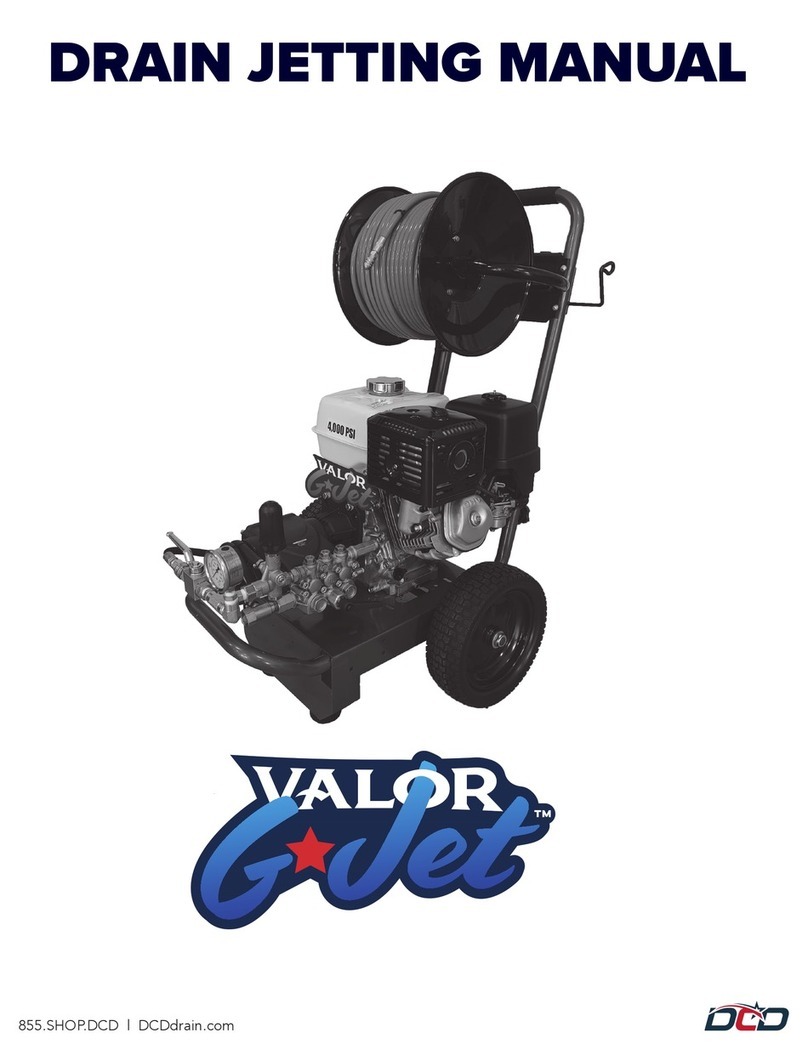DCD 61400-000 User manual

61400-000
Lineman Lasher
Operating Instructions

Page | 1
Contents
Specifications: .......................................................................................................... 2
Safety: ...................................................................................................................... 3
1. Loading the Wire Spools on the Lasher ............................................................... 4
2. Threading the Lashing Wire .................................................................................. 5
3. Adjusting the Wire Spool Brake: .......................................................................... 6
4. Setting the Front Gate: ........................................................................................ 6
5. To open the Strand Lock: ..................................................................................... 7
6. Setting the Rear Gate: ......................................................................................... 8
To adjust rear vertical rollers, follow these steps:- .................................................... 9
7. Clutch Trigger: ...................................................................................................... 9
8. Installing the overlash assembly front rollers: .................................................... 11
Troubleshooting ...................................................................................................... 11

Page | 2
LINEMAN LASHER
Part # 61400-000
Pull-Type Lasher
Specifications:
Lasher Weight: 38 lbs.
Lasher Dimensions: 19-1/2” long x 12” wide x 12” high
Capacity:
Single cable – 3” OD maximum
Multiple Cables – not to exceed 3” OD as a bundle
Capabilities:
The Lineman Lasher will single or double lash without strand traction. It is
compatible with standard size coils of .045” and .038” lashing wire, metallic or non-
metallic. Double lashing provides a support every 6”, while single lashing provides
a support ever 12”. It is also equipped with a clutch handle to allow easy mounting
and passing the unit around a pole without cutting the lashing wire or removing it
from the drive wheels.
General Information:
The DCD Lineman Lasher is a medium size lasher that has a decades of
performance history in the field. It weighs just 38 pounds (plus wire) and does not
need traction from the supporting strand to drive the lasher making it very beneficial
to use when overlashing existing cables.
This lasher is a piece of precision equipment. Treat is as such. Keep the lasher,
operating manual and accessories in the protective storage case after use. This
measure will prolong the useful life of your lasher.

Page | 3
Safety:
- The Lineman Lasher is intended for use only as described in this manual. Do not
modify or dismantle the lasher. It has been assembled and inspected and is only
covered by a warranty in its “as shipped” form. Any attempt to dismantle or modify
the lasher will void the warranty and may result in property damage, severe bodily
harm, or death.
- Keep hair, loose clothing, and all parts of body away from openings and moving
components. Wear gloves and other appropriate safety equipment to avoid pinch
hazards.
- Never use a worn, defective or incomplete equipment. Ensure that all components
of the setup are able to withstand the maximum pulling loads. Components not
rated for the pull force may break and release the stored energy during operation.
- Do not operate in live environment. The lasher is composed of metal components,
and tow ropes connected to the unit can conduct electricity. The weight of the lasher
can cause cables to sag and could increase proximity to live wires. Plan work
accordingly.
- Do not operate when judgement is impaired (medication, alcohol or otherwise).
Improper use can result in property damage, injury or death.
- Be aware of and follow all safety rules applicable to overhead cable installation,
including, but not limited to, the Occupational Safety and Health Act of 1970,
Subpart V - Power Transmission and Distribution.

Page | 4
1. Loading the Wire Spools on the Lasher
To prepare the Lineman Lasher for lashing, the first step is to load the lashing
wire. Whether using .045” or .038” lashing wire, follow these steps.
1a) Remove the wire spool flange by turning in clockwise rotation (left to right). To
keep spool from turning, insert finger in hole (or the end of a screw driver or
tool) on back side of well in cable opening in the drum.
1b) Cut two wire ties. Insert coil of wire on spool so coil of wire will turn in a
counterclockwise rotation (Right to left) when pulling on wire. (Load both
sides to rotate in a conterclockwise direction). Cut and remove remaining
twowire ties. Replace flange and tighten flange as tight as possible to keep
coil of wire from turning on wire spool. (To hold wire spool from turning when
tightening flange, insert finer in the hole located on back side of wire spool
well at bottom.)

Page | 5
2. Threading the Lashing Wire
You have loaded the lashing wire, now you are ready to thread the lashing wire.
Note that when facing the direction the Lasher will travel, the LHS is on your left and
the RHS is on your right.
2a) To thread lashing wire take ‘free’ end of lashing wire as it comes off the wire
spool, thread ‘tree’ end under the long roller. NOTE: Both wire spools must be
loaded and threaded to rotate in the same (counterclockwise) direction.
2b) Extend up along the outside of the friction wheel and around friction wheel
one time as per arrows. Bring wire off friction wheel and around front wire
guide roller then back to rear guide roller. Wire passes under rear guide roller.
NOTE: it is recommended that both sides be loaded with wire to help balance
the lasher, whether you are single or double lashing.

Page | 6
3. Adjusting the Wire Spool Brake:
To adjust the brake on the wire spool, insert brake adjustment wrench into center of
wire spool spindle, tighten brake only enough so wire spool will not turn freely when
loaded with a full coil of wire. This adjustment does not need to be done each time
you load lasher with wire.
4. Setting the Front Gate:
4a) To open front gate, pull front cable roller until lock releases. Then swing
roller completely open to clear the cable.

Page | 7
5. To open the Strand Lock:
To open the Strand Lock, follow these steps:-
4a) Pull the lever on the side of the strand lock.
4b) Rotate the top lever back (approx. 270°) and pull up into slot to swing the
strand lock out of the way. Note that the bend on the top lever matches the
alignment of the strand lock, so the position of the strand lock can be known
without having to look inside the machine.
Note that when overlashing, leave strand lock open.

Page | 8
4c) When the lever is in the open position, pull it upwards to lock into place. The
lever on the side of the strand lock should pop back in to lock the strand lock
into place. Pulling the side lever out will once again unlock the strand lock.
.
6. Setting the Rear Gate:
To open rear gate, follow these steps:
6a) To open rear gate, push release button on the bottom of the rear gate bracket
and swing open while button is still depressed. When the rear gate is open the
drum lock will be engaged and will automatically lock when the gate openings
are lined up. The lasher is ready to put on the line.
Place the lasher on the strand making sure the strand is centered in both strand
rollers. Close the strand lock by pushing the lever toward the machine until the
strand rollers close around the messenger. NOTE: Keep fingers away from the
arm as they may be pinched in the mechanisms while closing.
Place the cable up into the machine and swing front gate closed. Close the back
gate by pushing the release button and swinging the gate shut. This also
releases the drum lock. The rear horizontal (2) and vertical (3) rollers can now
be adjusted to center and contain the cable. Tie off the lashing wire, attach the
tow rope to the eyelets on the front of the machine. The machine is ready to
lash.

Page | 9
5c) To adjust the height of the rear gate roller up or down, scroll the knurled roller
and the gate will wind up or down. During operation this gate should be set to
within 1/8” of the cable.
To adjust rear vertical rollers, follow these steps:-
5d) Adjust rear vertical rollers by turning the knurled roller located at top between
rear rollers.
7. Clutch Trigger:
7a) The clutch trigger disengages the drive mechanism from rotating the drum.
This is used when handling the lasher around the utility pole making it
unnecessary to unthread the lashing wire when passing the lasher.
At the end of lashing a span, open the strand lock and both front and back gates,
rotate the drum until it lock in place. Depress trigger and hand around the utility
pole.

Page | 10
7b) Should slippage occur in the drive wheels, two screw adjustments have been
provided for easy maintenance. Take the hex wrench supplied with the
machine and turn the screws clockwise (left to right) to tighten. Do not tighten
too much as this will make the machine hard to pull and cause premature wear.
You are now ready to proceed to place the Lineman Lasher on the supporting
strand. Position the cable in the lasher. Close front and rear gates. Adjust rear
rollers to center cable. Raise the clutch handle to allow additional wire to be pulled
out of the machine without rotating the machine to tie off lashing wire to strand.
Attach towing rope to pulling rings on front of lasher.

Page | 11
8. Installing the overlash assembly front rollers:
DCD offers the 61438-000 Overlash assembly for installing larger cables or
overlashing smaller cables to existing bundles.
8a) To install, remove the bumper plate provided with your lasher by removing the
two flat head screws on the front of the unit. Install the Overlash assembly in
place of the bumper plate as shown so that the side rollers are in a vertical
position at the front opening of the machine.
Troubleshooting
If lashing wire won’t pay out:
This indicates the wire isn’t threaded properly. Refer to “Threading the Lashing
Wire”.
NOTE: If you are unable to achieve positive drive, the lashing wire can be
threaded twice around the drive wheel.
NOTE: If using metallic wire and machine is difficult to pull, the wire can be
threaded in the opposite direction on the drive wheel. If using non-metallic
lashing wire, always thread in the standard indicated fashion.

Page | 12
If wire jumps off drive wheel:
This also indicates the lashing wire is improperly threaded. Refer to “Threading the
Lashing Wire”.
If lasher draws back and loosens lashing wire:
Just pull lasher forward. The wire will tighten.
If you need any parts or repairs:
Contact DCD Design & Manufacturing Inc. at 1-888-794-8357.

Page | 13
NOTES
Table of contents
Other DCD Industrial Equipment manuals




















